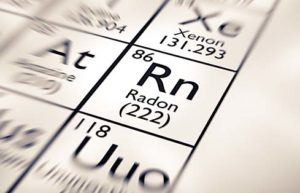Radon
What is radon?
Radon is a naturally-occurring radioactive gas. Found on the periodic table, it is a chemical element that is expressed by the symbol Rn. Radon is an isotope of radium and has the shortest half-life of all the radioactive isotopes. This noble gas is colorless, tasteless, and odorless. It is easily inhaled, making it a health hazard.
What are the dangers of radon?
Sometimes, radon gas can accumulate in homes. These homes are often built upon soft natural soils that contain natural uranium deposits. The radon invades the home through cracks in the floors and walls. It can even creep in through construction joints or in gaps around electrical wires and service pipes. Radon is dangerous and causes tens of thousands of deaths per year.
What are the effects of radon?
Experts have expressed that in small quantities, radon gas can be harmless. When the gas enters the body, it exposes the lungs to small amounts of radiation. If exposure is persistent or in larger quantities, radon can damage the cells that line the lungs. The damage caused by radon can increase the risk of developing lung cancer.
What are safe or dangerous radon levels?
While no radon gas level is considered safe, Radon Act 51 was passed by congress, setting the target for radon levels that occur naturally outdoors and indoors. This act set the ideal level for radon gas at 0.4 pCi/L. Two-thirds of the United States homes exceed this level, pushing the EPA to increase the actionable level for radon to 4 pCi/L. Although this is not considered a safe level, the EPA estimates that cancer risk can be reduced if levels are below 2 pCi/L.
How to test for radon?
Due to radon presentation being colorless, tasteless, and odorless, testing is the only true way of determining the levels within a home. Testing for radon can be done in three ways – short-term (two to seven days), long-term (90 days to a year), and continuous (much like a carbon monoxide monitor, but plugs into a standard outlet).
How to remove radon?
The first plan of attack against radon in the home is to caulk and seal all the entry points. This measure alone is not enough to reduce the risk of exposure. A cost-effective and proven reliable mitigation technique for radon is active soil depressurization (ASD). The system can be simple or complex, but it collects the gas from beneath the building before entering the home. Radon mitigation can also be known as radon remediation.
Radon & Real Estate (Buying or Selling A Home)
If you are buying or selling a home, the EPA recommends executing a radon test for the property. Taking appropriate actions to mitigate any radon problems within a home before purchase or sale can be positive real estate factors. The EPA recommends that when building a home, proactive measures be included to mitigate radon’s risk entering the home.
 Our Response to COVID-19
Our Response to COVID-19 

